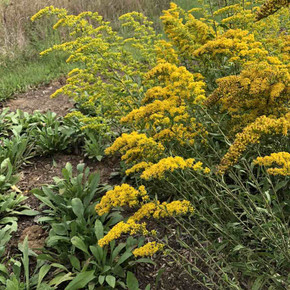

Please note your preferred ship date/week in the "Order Comments" section at checkout.
Otherwise, please allow 1-3 weeks to receive your order.
See the "Shipping" page under "Company Information" for our default ship dates based on hardiness zone.
We are unable to ship to any US Territories, AK, AZ, CA, CO, HI, ID, MT, NM, NV, OR, UT, WA, or WY
A bit earlier blooming goldenrod that's great in partial shade, on woodland edges and difficult to predict sun-shade transitioning areas.
Pollinator magnet as any other goldenrod.
Blooming Time: starts a bit earlier than other goldenrods, August - September
Size: usually 26-30" tall x 12-16" wide (in rich soils can reach up to 48", but then often needs staking)
USDA Zones: 4 to 8
Culture: half sun, partial sun, half shade to light shade. Average soils, leaner soils, preferably with some drainage, medium, medium-dry to dry soil. Adaptable, avoid waterlogged soils! Drought tolerant. Too rich soils mean too tall plants and flopping (so staking), or cutting plants back in early summer for shorter growth.
Moisture Needs: medium (average), medium-dry to dry
Origin: Native to AL, AR, CO, FL, GA, IL, KS, LA, MO, NC, NE, NM, OK, SC, TX where can be found in woodland edges, upland woodlands and savannas, thinly wooded rocky bluffs, thickets, glades, in and rocky prairies, in the woods on sandy soils. See the BONAP map of distribution.
Black Walnut Tolerant: yes
Deer/Rabbit Resistant: it's not preferred, but young shoots and leaves can be browsed by both
Attracts Butterflies or Pollinators: yes / yes. Just like any other goldenrods attracts wide variety of insects, including honeybees, bumblebees, little carpenter bees, leaf-cutter bees, Halictid bees, masked bees, Andrenid bees, wasps, Syrphid flies and other flies, butterflies (including Monarchs), skippers, and beetles. Several species mine or feed on the plants - leaf beetles, larvae of leaf-miner flie, larvae of gall flies, plant bugs (Lygus spp., Polymerus spp., Slaterocoris spp.), Corythucha marmorata (Goldenrod Lace Bug), aphids (Uroleucon spp.), treehoppers (Stictocephala spp.), Aonidomytilus solidaginis (Goldenrod Scale), larvae of several moths (Gelechiid moths,Goldenrod Flower Moth, other Noctuid moths, several Tortricid moths, and grasshoppers.
Attracts Hummingbirds: no / but small songbirds are attracted to the seeds (Indigo Bunting, American Goldfinch, Slate-colored Junco, and Tree Sparrow). The Greater Prairie Chicken feeds on the foliage and flowerheads
Pot Size: Square 3.5" x 4" deep perennial pot
Plant Combinations: Best in drier transition edges of gardens (difficult to predict partial shade spots), or woodland edges, naturalistic gardens, gardens on drained, rocky or sandy soils. Good with many common perennials that tolerate drained or drier soils : Echinacea, Achillea, Agastache, Amsonia, summer blooming Allium, Asclepias tuberosa, Aster, Baptisia, Calamintha, Coreopsis, Gaura, Knautia, Liatris, Monarda, Nepeta, Oenothera, Penstemons, Platycodon (taller ones), Rudbeckia, Salvia nemorosa hybrids, tall Sedum, other Solidago, Stachys, Vernonia lettermannii, taller Veronica, Yucca, and grasses like Bouteloa, Muhlenbergia, Sporobolus, Schizachyrium scoparium, Sorghastrum or Panicum.
Picture Copyright: Georgia Native Plant Society
A bit earlier blooming goldenrod that's great in partial shade, on woodland edges and difficult to predict sun-shade transitioning areas.
Pollinator magnet as any other goldenrod.
Blooming Time: starts a bit earlier than other goldenrods, August - September
Size: usually 26-30" tall x 12-16" wide (in rich soils can reach up to 48", but then often needs staking)
USDA Zones: 4 to 8
Culture: half sun, partial sun, half shade to light shade. Average soils, leaner soils, preferably with some drainage, medium, medium-dry to dry soil. Adaptable, avoid waterlogged soils! Drought tolerant. Too rich soils mean too tall plants and flopping (so staking), or cutting plants back in early summer for shorter growth.
Moisture Needs: medium (average), medium-dry to dry
Origin: Native to AL, AR, CO, FL, GA, IL, KS, LA, MO, NC, NE, NM, OK, SC, TX where can be found in woodland edges, upland woodlands and savannas, thinly wooded rocky bluffs, thickets, glades, in and rocky prairies, in the woods on sandy soils. See the BONAP map of distribution.
Black Walnut Tolerant: yes
Deer/Rabbit Resistant: it's not preferred, but young shoots and leaves can be browsed by both
Attracts Butterflies or Pollinators: yes / yes. Just like any other goldenrods attracts wide variety of insects, including honeybees, bumblebees, little carpenter bees, leaf-cutter bees, Halictid bees, masked bees, Andrenid bees, wasps, Syrphid flies and other flies, butterflies (including Monarchs), skippers, and beetles. Several species mine or feed on the plants - leaf beetles, larvae of leaf-miner flie, larvae of gall flies, plant bugs (Lygus spp., Polymerus spp., Slaterocoris spp.), Corythucha marmorata (Goldenrod Lace Bug), aphids (Uroleucon spp.), treehoppers (Stictocephala spp.), Aonidomytilus solidaginis (Goldenrod Scale), larvae of several moths (Gelechiid moths,Goldenrod Flower Moth, other Noctuid moths, several Tortricid moths, and grasshoppers.
Attracts Hummingbirds: no / but small songbirds are attracted to the seeds (Indigo Bunting, American Goldfinch, Slate-colored Junco, and Tree Sparrow). The Greater Prairie Chicken feeds on the foliage and flowerheads
Pot Size: Square 3.5" x 4" deep perennial pot
Plant Combinations: Best in drier transition edges of gardens (difficult to predict partial shade spots), or woodland edges, naturalistic gardens, gardens on drained, rocky or sandy soils. Good with many common perennials that tolerate drained or drier soils : Echinacea, Achillea, Agastache, Amsonia, summer blooming Allium, Asclepias tuberosa, Aster, Baptisia, Calamintha, Coreopsis, Gaura, Knautia, Liatris, Monarda, Nepeta, Oenothera, Penstemons, Platycodon (taller ones), Rudbeckia, Salvia nemorosa hybrids, tall Sedum, other Solidago, Stachys, Vernonia lettermannii, taller Veronica, Yucca, and grasses like Bouteloa, Muhlenbergia, Sporobolus, Schizachyrium scoparium, Sorghastrum or Panicum.
Picture Copyright: Georgia Native Plant Society
